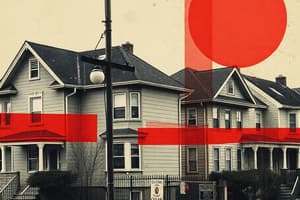Podcast
Questions and Answers
What is redlining?
What is redlining?
- Illegal practice of refusing to make mortgage loans or issue insurance policies in specific areas (correct)
- A zoning regulation
- A form of urban planning
- A community development strategy
What does Homer Hoyt's Sector model explain?
What does Homer Hoyt's Sector model explain?
The internal structure of cities with social groups arranged in sectors.
Define nucleated settlement.
Define nucleated settlement.
A settlement with one or more core areas where families live in close proximity surrounded by fields.
What is a slum?
What is a slum?
What is a squatter settlement?
What is a squatter settlement?
Describe a grid street pattern.
Describe a grid street pattern.
What characterizes a dendritic street pattern?
What characterizes a dendritic street pattern?
What defines a suburb?
What defines a suburb?
Define suburbanization.
Define suburbanization.
What is a tenement?
What is a tenement?
Define town in urban geography.
Define town in urban geography.
What is an underclass?
What is an underclass?
Define underemployment.
Define underemployment.
What is the concept of urbanization?
What is the concept of urbanization?
What are world cities?
What are world cities?
Define zone in transition.
Define zone in transition.
What are zoning ordinances?
What are zoning ordinances?
Define base ratio.
Define base ratio.
What is Bosnywash?
What is Bosnywash?
Define center city.
Define center city.
What is a city-state?
What is a city-state?
Define complementary region.
Define complementary region.
What are councils of government?
What are councils of government?
Define disamenity sector.
Define disamenity sector.
What are export activities?
What are export activities?
What does feminization of poverty refer to?
What does feminization of poverty refer to?
What is formative era in urban geography?
What is formative era in urban geography?
Define greenbelts.
Define greenbelts.
What is a hamlet?
What is a hamlet?
Flashcards are hidden until you start studying
Study Notes
Key Terms in Urban Geography
-
Redlining: An illegal practice where mortgage loans or insurance policies are denied based on location rather than economic eligibility.
-
Homer Hoyt's Sector Model: Illustrates urban structures with social groups organized in sectors or wedges radiating from a central business district.
-
Nucleated Settlement: A community structure where families reside in close proximity, surrounded by their fields and farm structures.
-
Slum: An area characterized by extreme poverty and poor living conditions within a city.
-
Squatter Settlement: Communities in developing nations where individuals build homes illegally on land they do not own or rent.
-
Grid Street Pattern: A street layout where roads intersect at right angles, promoting systematic navigation.
-
Dendritic Street Pattern: A network of streets that branch outward from a central point, resembling a tree's structure.
-
Suburb: Residential areas situated on the outskirts of a city, typically characterized by lower density.
-
Suburbanization: The demographic shift of populations moving from urban centers to the outskirts, often leading to urban sprawl.
-
Tenement: Poorly maintained apartment buildings that only meet minimal living standards, often home to low-income residents.
-
Town: An urban area defined by specific boundaries, smaller than a city.
-
Underclass: A demographic of people enduring persistent poverty, often through multiple generations.
-
Underemployment: A situation where workers possess qualifications higher than their job requirements or work fewer hours than desired.
-
Urban Hierarchy: A system that ranks urban areas based on their size, population, and the range of services they provide.
-
Urbanization: The movement of populations from rural regions to cities, contributing to urban growth.
-
World City: Major global centers of economic, cultural, and political influence, interlinked in finance and commerce.
-
Zone in Transition: Areas undergoing changes between rural and urban characteristics, often with socio-economic implications.
-
Zoning Ordinances: Regulations that govern land use and establish density limits for development in communities.
-
Base Ratio: The relationship between employment in the basic economic sector versus the non-basic sector.
-
Bosnywash: A heavily populated corridor stretching from Boston to Washington D.C., including major cities like New York and Philadelphia.
-
Center City: The urban core providing goods and services to surrounding areas, typically more densely populated.
-
City-State: A sovereign entity consisting of a city that governs itself and its surrounding territory.
-
Complementary Region: Areas that provide distinct activities or strengths, benefitting from their economic interdependence.
-
Councils of Government: Collaborative agencies formed by representatives from local governments to address regional issues.
-
Disamenity Sector: The most impoverished urban areas, often lacking basic city services and controlled by gangs or illegal organizations.
-
Export Activities: The processes involved in sending goods out of a region to other markets.
-
Feminization of Poverty: An increasing trend where women represent a growing segment of the impoverished population.
-
Formative Era: The historical period during which major urban centers were established.
-
Greenbelts: Protected undeveloped areas surrounding cities in Europe, aimed at preserving open space and preventing urban sprawl.
-
Hamlet: A small community or settlement that is even less populated than a village.
Studying That Suits You
Use AI to generate personalized quizzes and flashcards to suit your learning preferences.




